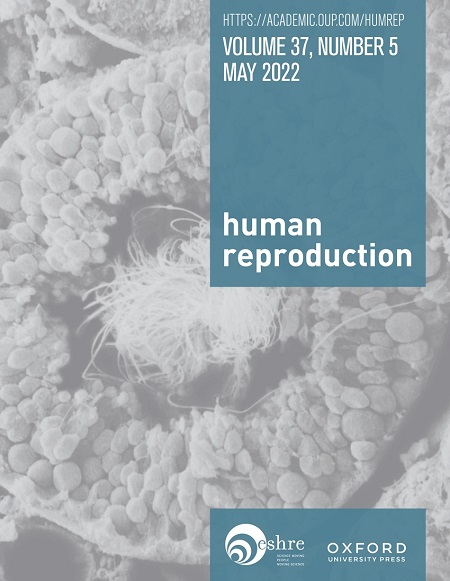乙型肝炎病毒感染与卵母细胞质量、胚胎发育和抗逆转录病毒治疗结果的关系。
IF 6.1
1区 医学
Q1 OBSTETRICS & GYNECOLOGY
引用次数: 0
摘要
研究问题:女性或男性乙型肝炎病毒(HBV)感染是否影响接受抗逆转录病毒治疗的不育夫妇的卵母细胞和胚胎质量、妊娠结局和新生儿结局?女性或男性HBV感染对ART治疗的卵母细胞和胚胎发育、妊娠结局或新生儿结局没有统计学上显著的负面影响。只有少数研究评估了乙肝病毒感染对不育人群生殖结果的影响,结果不一致。目前对hiv感染女性和男性的卵母细胞和胚胎发育的研究有限。研究设计、规模、持续时间:一项回顾性队列研究在2011年1月1日至2023年3月31日期间,在第一次卵巢刺激后进行第一次冷冻胚胎移植(FET)的不育夫妇中进行。参与者/材料、环境、方法共24836对不育夫妇,包括133对女性hbv阳性和男性hbv阴性的夫妇,1471对女性hbv阴性和男性hbv阳性的夫妇,23232对女性和男性hbv阴性的夫妇在第一次卵巢冷冻刺激后接受了第一次FET治疗。使用倾向评分匹配(PSM)来平衡各组之间的基线参数。PSM后,对照组(女性hbv阳性组和男性hbv阴性组、女性hbv阴性组和男性hbv阳性组)与对照组在取卵数、MII卵母细胞数、1-2-3 pn受精卵母细胞数、2pn受精卵母细胞数、胚胎卵裂数、可用胚胎数、优质胚胎数、可用囊胚数等方面比较,差异均无统计学意义。对照组与对照组的成熟卵母细胞率、受精率、卵裂率、优质胚率、有效胚率差异均无统计学意义。女性HBV感染夫妇的临床妊娠率和活产率与未感染夫妇相比呈下降趋势,但未达到统计学意义(临床妊娠:校正优势比为0.69 [95% CI: 0.45-1.05],活产率为0.64[0.41-1.00])。女性HBV感染夫妇和男性HBV感染夫妇与新生儿不良结局(包括早产、低出生体重、高出生体重、小胎龄和大胎龄)风险增加无关。局限性和谨慎的原因这是一项单中心的回顾性队列研究,限制了我们结果的推广。shbv感染与卵母细胞发育、胚胎质量、妊娠结局和新生儿结局没有统计学上的显著相关性。这些发现表明,不应因为担心负面影响而阻止感染HBV的不育女性或男性寻求抗逆转录病毒治疗。研究资助/竞争利益(S)本研究由国家自然科学基金(批准号:82273634,81903324)、上海交通大学跨学科项目(YG2019QNA19)和第二轮市级医院促进临床技能和临床创新新三年行动计划“研究型医师创新转化能力力量训练计划”(SHDC2023CRS031)资助。没有需要申报的利益冲突。试验注册号/ a。本文章由计算机程序翻译,如有差异,请以英文原文为准。
Association of hepatitis B virus infection with oocyte quality, embryo development, and ART outcomes in couples with a freeze-all strategy at a single center.
STUDY QUESTION
Does female or male hepatitis B virus (HBV) infection affect the oocyte and embryo quality, pregnancy outcomes, and neonatal outcomes in infertile couples undergoing ART treatment?
SUMMARY ANSWER
The female or male HBV infection did not have a statistically significant negative impact on the development of oocytes and embryos, pregnancy outcomes, or neonatal outcomes of ART.
WHAT IS KNOWN ALREADY
Only few studies assessing the effects of HBV infection on the reproductive outcomes among infertile population have been conducted with inconsistent results. There is limited research that focuses on the oocyte and embryo development of HBV-infected females and males.
STUDY DESIGN, SIZE, DURATION
A retrospective cohort study was performed among infertile couples undergoing the first frozen embryo transfer (FET) after the first ovarian stimulation with a freeze-all strategy during the period from 1 January 2011 to 31 March 2023.
PARTICIPANTS/MATERIALS, SETTING, METHODS
A total of 24 836 infertile couples, including 133 couples with female HBV-positive and male HBV-negative, 1471 couples with female HBV-negative and male HBV-positive, and 23 232 couples with both female and male HBV-negative underwent their first FET after the first ovarian stimulation with a freeze-all strategy. Propensity score matching (PSM) was used to balance the baseline parameters between the groups.
MAIN RESULTS AND THE ROLE OF CHANCE
After PSM, no statistically significant differences were observed regarding the comparison in the number of oocytes retrieved, MII oocytes, 1-2-3 PN-fertilized oocytes, 2PN-fertilized oocytes, embryo cleavages, available embryos, top-quality embryos, and available blastocysts between comparison groups (group with female HBV-positive and male HBV-negative and group with female HBV-negative and male HBV-positive) and the reference group. Consistently, the differences in the mature oocyte rate, fertilization rate, cleavage rate, as well as top-quality embryo rate and available embryo rate between comparison groups and the reference group were not statistically significant. The clinical pregnancy rate and the live birth rate showed a decreasing trend for couples with female HBV infection compared with the uninfected couples, although this did not reach statistical significance (clinical pregnancy: adjusted odds ratio, 0.69 [95% CI: 0.45-1.05] and live birth: 0.64 [0.41-1.00]). Couples with female HBV infection and couples with male HBV infection were not associated with increased risk of adverse neonatal outcomes including preterm birth, low birth weight, high birth weight, small for gestational age, and large for gestational age.
LIMITATIONS, REASONS FOR CAUTION
This was a retrospective cohort study in a single center, which limited the generalization of our results.
WIDER IMPLICATIONS OF THE FINDINGS
HBV infection was not statistically significantly associated with development of oocyte and embryo quality, pregnancy outcomes, and neonatal outcomes. These findings indicate infertile women or male with HBV infection should not be prevented from seeking ART due to concerns about negative effects.
STUDY FUNDING/COMPETING INTEREST(S)
This study was funded by the National Natural Science Foundation of China (grant nos. 82273634, 81903324), the interdisciplinary program of Shanghai Jiao Tong University (YG2019QNA19), and the second round of Promoting clinical skills and clinical innovation in municipal hospitals New three-year Action Plan "Research physicians innovation and transformation ability Strength training program" (SHDC2023CRS031). There are no conflicts of interest to declare.
TRIAL REGISTRATION NUMBER
N/A.
求助全文
通过发布文献求助,成功后即可免费获取论文全文。
去求助
来源期刊

Human reproduction
医学-妇产科学
CiteScore
10.90
自引率
6.60%
发文量
1369
审稿时长
1 months
期刊介绍:
Human Reproduction features full-length, peer-reviewed papers reporting original research, concise clinical case reports, as well as opinions and debates on topical issues.
Papers published cover the clinical science and medical aspects of reproductive physiology, pathology and endocrinology; including andrology, gonad function, gametogenesis, fertilization, embryo development, implantation, early pregnancy, genetics, genetic diagnosis, oncology, infectious disease, surgery, contraception, infertility treatment, psychology, ethics and social issues.
 求助内容:
求助内容: 应助结果提醒方式:
应助结果提醒方式:


